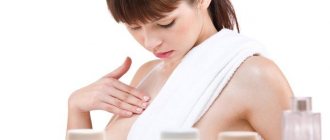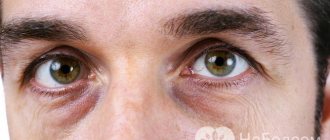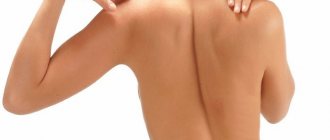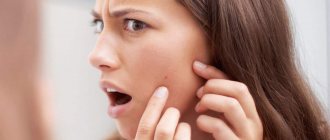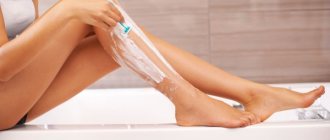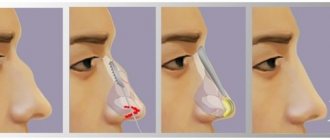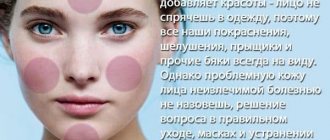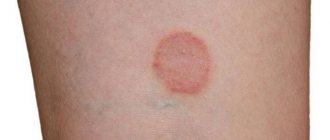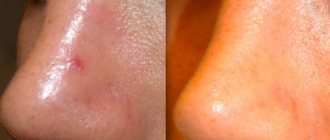What it is
Acne is an inflammatory change in the epidermis associated with disruption of the sebaceous glands. Acne is called acne. Red, inflamed acne is often caused by bacteria.
Acne on your back can ruin your appearance and make it difficult to wear the clothes you want. They can also cause itching and pain when touched or in contact with clothing.
Preventative tips
Remember simple rules:
- take care of your body;
- do not use alcohol-containing products to care for problem skin;
- eat right;
- treat chronic diseases;
- give up bad habits;
- wear things made from natural fabrics;
- use cosmetics suitable for your skin type.
Acne on the back is unsightly, uncomfortable, and unhealthy. Recommendations from specialists will help you get rid of rashes. Read the material again, choose the appropriate recipes, visit a dermatologist and start fighting skin rashes.
From the following video you can learn even more about back acne:
Signs
Signs of acne are immediately visible. Usually these are numerous formations that can have different appearances.
Main types of acne:
- White. They are formed due to blockage of the sebaceous ducts. They look like white dots. Popularly called “millet”. They may be painless to the touch and not cause discomfort.
- Black. They also appear due to the closure of the pores. Black color is acquired by oxidation. They also don’t hurt or itch.
- Reds. Inflamed acne. They appear when an infection gets inside the pore. They usually hurt and may itch.
- Subcutaneous. As the name suggests, they are located deep under the skin. They look like red lumps. They cannot be squeezed out. Very painful when touched.
- Purulent. The most severe rashes. They talk about serious disorders in the body. If squeezed, they can cause blood poisoning. They hurt a lot. The pores may release green pus and an unpleasant odor.
Types and classification
There are several types of acne that form on the back. Each has features that influence treatment options.
Subcutaneous This variety belongs to closed comedones. How does a subcutaneous pimple appear? The pores are blocked by horny scales, the fat does not find its way to the surface. An internal cyst appears.
The formation lies dormant under the skin until an internal infection develops or the person attempts to squeeze out the comedone. (You can find out more about subcutaneous acne in this article).
Red pimples Occur due to bacterial inflammation of the acne cavity. Inflammation of the comedone leads to the appearance of a cone-shaped pimple with purulent contents at the end.
One of the common types of rashes, a lot of acne occurs on the back due to the high activity of the sebaceous glands in the shoulders, back and chest;
Blackheads One of the forms of acne is a type of open comedones. Most people suffering from blackheads have oily skin and seborrhea. The reason for its appearance is the accumulation of sebum at the mouth of the hair follicle. Most often they occur on the face and back.
Dust, dirt, and scales stick to the oily surface, closing the pores. In air, the fat clot oxidizes and gradually turns black. Pathogenic microorganisms provoke an inflammatory process around open comedones. (About acne on the face is written at this address).
Purulent acne Red acne easily turns into ulcers if left untreated. Taking care of the skin on your back is quite inconvenient; dirt, sweat, and remnants of skin flakes often accumulate there. Favorable conditions are created for the inflammatory process.
The fight against ulcers will prevent blood poisoning and infection of the entire body. Not taking the problem of pustules seriously allows the formations to grow to incredible sizes, causing large pimples to appear on the back.
Causes of acne on the back in women
Acne on the back most often appears in men, because their sebum production is much higher than that of women. However, this problem can also occur in women because the epithelium on the back is usually fattier than in other areas.
The causes of acne are the same for all types of acne:
- hormonal imbalance;
- diseases of the digestive system;
- damage to the sebaceous glands;
- poor nutrition;
- smoking, drinking alcohol, as well as bad habits;
- harmful work;
- improper skin care;
- dirty air or water;
- allergic reaction;
- low-quality clothing made from synthetic fibers;
- stress.
Treatment of the disease
How to cure and remove acne on the back? Before starting therapy, undergo a complete examination. Find out what factor triggered the rash. Sometimes identifying the cause is more difficult than treating acne, but “blind” therapy can not only end in vain, but also cause harm.
Visit:
- dermatologist;
- gastroenterologist;
- gynecologist;
- endocrinologist;
- allergist.
After passing the tests, the doctor will prescribe effective medications. Treatment will be successful if several factors are combined.
Five prerequisites:
- a well-chosen set of medicines;
- a strong desire to get rid of acne, the presence of willpower in the patient;
- willingness to change your daily routine and give up bad habits;
- adherence to the principles of healthy eating;
- use of traditional medicine recipes.
Diagnostics
As you can see, the reasons can be both internal violations and external influences. To determine the exact cause, you must consult a doctor. Based on the type of rash, a dermatologist can determine what exactly caused it.
Women with acne need to consult a gynecologist. Since the cause of this phenomenon may be gynecological diseases. For a correct diagnosis, consultation with at least three doctors is necessary - a dermatologist, a gynecologist and a therapist.
Reasons for the formation of marks
Acne is a small inflammatory process.
First, spasm of blood vessels is observed at the site of inflammation. Then they expand. The local temperature rises, the pimple matures. The response to this process is the concentration of protective cells - leukocytes, which destroy the infection. After this, the integrity of the tissue is restored and new vessels are formed.
After the acne disappears, white scars or dark (blue, red, brown) pigment spots form. They are areas of the body with impaired blood microcirculation.
Usually post-acne disappears on its own - it takes several weeks or months. In advanced cases, cosmetic procedures are recommended.
Antibacterial drugs
Antibiotic treatment is prescribed when internal problems are not detected, and acne appears due to pathogenic microbes that have entered the epithelium.
You cannot do this treatment yourself. If acne is caused by diseases of the digestive organs or due to a hormonal imbalance, the situation can only worsen.
There is a wide variety of antibiotics. There are broad-spectrum drugs, and there are those that act on specific bacterial pathogens.
Therefore, the selection of tablets should be done by a doctor. Before this, he will do tests in order to find out which microbes affect the body.
Antibacterial drugs exist in the form of tablets, for oral administration, or in the form of ointments for external use.
Do not think that ointments are safer and that you can prescribe them to yourself. Despite the fact that they are used externally, the active substances can be absorbed and enter the bloodstream.
When taking it, you need to remember that antibiotics can negatively affect the beneficial intestinal microflora and take supportive medications.
Irritation
The rash, which is small in size and looks like pustules, is the result of prolonged wearing of synthetic T-shirts and blouses. These fabrics do not allow air to pass through and do not absorb moisture. That's why this kind of irritation appears.
The human body cannot “breathe” normally and because of this, this kind of trouble appears. It is very simple to cure such a rash - you just need to change clothes to those made from natural fabrics, and most often these are cotton dresses and T-shirts.
Pimples that appear as a result of irritation do not require any special treatment.
Topicals
Pharmaceutical companies offer a large number of topical acne medications. The most commonly used antibiotic ointments contain zinc and vitamin A retinoids.
Antibiotic cream:
- levomekol;
- erythromycin ointment;
- tetracycline;
- syntomycin;
- benzamicin;
- zenerite
Ointments are arranged as the effectiveness and severity of the drug increases. The latter is not the heaviest, but one of the most effective. Used to treat adolescents.
Zinc ointment is a more natural preparation that contains fewer contraindications and side effects. It dries well, thereby removing excess formation of subcutaneous fat. Kills germs.
Retinoids are drugs containing subtypes of vitamin A. Some consider them the safest and most effective treatment, while others call them extremely dangerous. The annotations for the drugs indicate that it should be used only if other methods have not helped.
It is especially worth considering the use of women. The instructions indicate that the attending physician must make sure that the woman is not pregnant and that she is using at least 2 methods to prevent pregnancy.
The drug should strictly not be used by pregnant or breastfeeding women, because it can cause defects in the child’s body. When taken, allergic reactions, visual disturbances and even burns may occur.
A large dose of vitamin A thins the skin, renews the epithelium and allows subcutaneous sebum to come out without clogging the pores - this is the principle of action of these ointments.
Folk remedies:
- Sea salt baths can draw out formations from pores. Pour a teaspoon of sea salt into a glass of water and dissolve completely. Wash problem areas with this solution.
- Calendula tincture kills bacteria and germs and promotes healing. Apply directly to acne twice a day.
- A clay mask diluted with water wonderfully dries and cleanses. The result will be visible literally from the first use. Apply the prepared solution for 30 minutes and rinse with warm water.
- Taking baths with the addition of a decoction of herbs such as chamomile, St. John's wort, and celandine is beneficial. You can also add 15 drops of orange, grapefruit, lemon or tea tree essential oils to the water. This will soothe and disinfect the skin.
Acne marks
After deep purulent rashes, ugly spots, scars, and scars often remain. For some people, the marks are barely noticeable, for others they are a cosmetic defect.
Modern dermatology distinguishes 4 types of scars:
- physiological. The scars heal quickly, leaving virtually no marks;
- atrophic. They look like a round, rectangular hole. Often have jagged edges. The color is the same as that of healthy skin;
- hypertrophic. Dense pink formations rise above the epidermis. A large amount of scar tissue is involved;
- keloids. Outwardly similar to hypertrophic ones, but darker in color. This type of scarring disfigures the body. A person is embarrassed to go to the beach or wear a dress with an open back. (We have a separate article about keloid scars).
Modern methods will help get rid of scars. The cosmetology clinic will offer you:
- skin polishing;
- ultrasonic peeling;
- healing masks;
- fractional photothermolysis;
- vacuum cleaning;
- microcurrent treatment.
Folk remedies are effective. Apply the suggested components to the scar tissue.
Use:
- sandalwood oil;
- tomato juice;
- banana;
- lemon juice;
- cucumber pulp;
- almond oil;
- parsley juice;
- apple cider vinegar with water (1:3);
- mask made of white clay and rosemary oil.
Diet therapy
Diet is very important in treatment. If you eat improperly, the liver and kidneys cannot cope with large amounts of fat and harmful substances, and this can affect your appearance.
By adhering to proper nutrition, we give the body the opportunity to cleanse itself on its own, and the skin will definitely thank you for this!
Proper nutrition for acne:
- try to give up fried, fatty and fast food;
- reduce coffee consumption to a minimum (if you do not have problems with blood pressure);
- avoid chips, crackers, processed foods and anything containing preservatives and dyes;
- replace fatty meat with dietary meat (chicken, turkey, rabbit), and eat only non-fatty fish (cod, haddock, silver hake, pollock, river perch, pike perch, bream, pike, roach, mullet, flounder, all types of shellfish and families cancerous);
- eat as many fruits and vegetables as possible, preferably fresh;
- drink as much water as possible, even if you don’t feel like it.
Allergy
The second reason is allergies. Most often it occurs due to cosmetic products that we use every day. This also includes washing powders and fabric softeners.
Of course, it’s difficult to give up using your favorite orchid-scented shower gel or body cream with a subtle strawberry scent. What could cause the allergy in this case?
- This or that component in a cosmetic product for daily use.
- A hidden comedogenic effect, which in most cases manufacturers do not mention. Instead of cleansing the pores of the skin, they literally cover them with oils or silicone, which is included in many body care products.
- Wrong choice of product - increased fat content of the cream or too thick consistency of the shower gel. They will create ideal conditions for the growth of bacteria on the back, which is the cause of acne and pimples.
- Incomplete removal of cosmetic product after use. Yes, this happens when the gel or foam has not been completely washed off the body.
If acne suddenly appears on your back, be sure to think about whether this or that bottle that is on the shelf in the bathroom is the cause. If this is the case, then after stopping use of this remedy, the rash most often goes away on its own and no treatment is required.
Photo
Salon treatments
Microneedling
If acne causes deep scars, topical treatments may not help. In this case, it is recommended to consult a dermatologist. Depending on the condition of the skin, the specialist will select a hardware procedure or concentrated peeling.
You can get rid of hypertrophic scars using injections: products that have a resolving effect are injected under the skin. The main drugs are interferons and corticosteroids.
Microneedling is used to treat atrophic scars. The main goal of therapy is to activate the renewal and protection of the epidermis. The influence of a special device, a mesoscooter, helps reduce the depth of scars. Duration of treatment is up to 9 months.
To get rid of round or rectangular atrophic scars, fillers are used. A product based on collagen and hyaluronic acid is injected under the skin. As a result, the scars are filled in and the severity of pigmentation is softened.
Laser resurfacing is used to correct all types of post-acne. The top layer of skin is removed with laser flashes. The procedure is performed under local anesthesia.
To treat deep post-acne, chemical peels are performed. Products with a high concentration of acids help dissolve the top layer of the skin. This causes dead cells to slough off.


